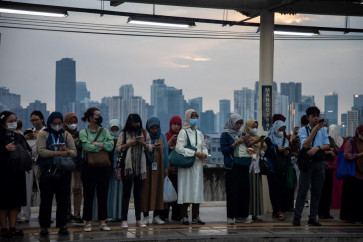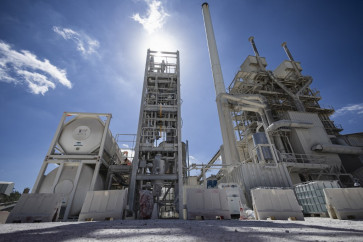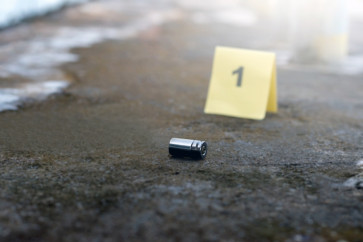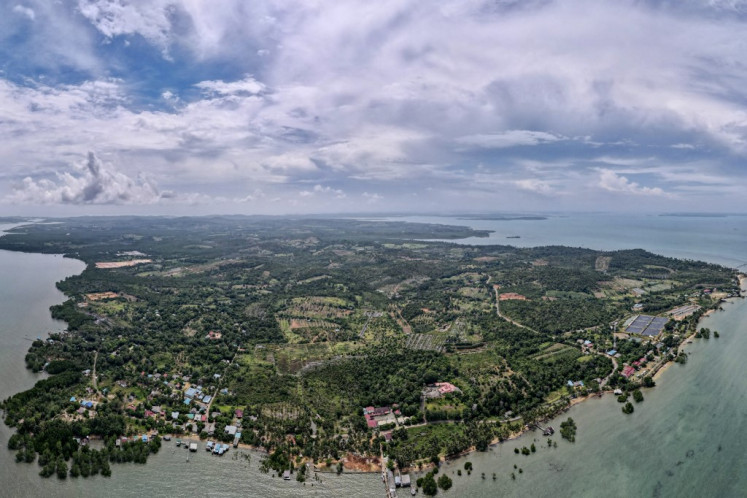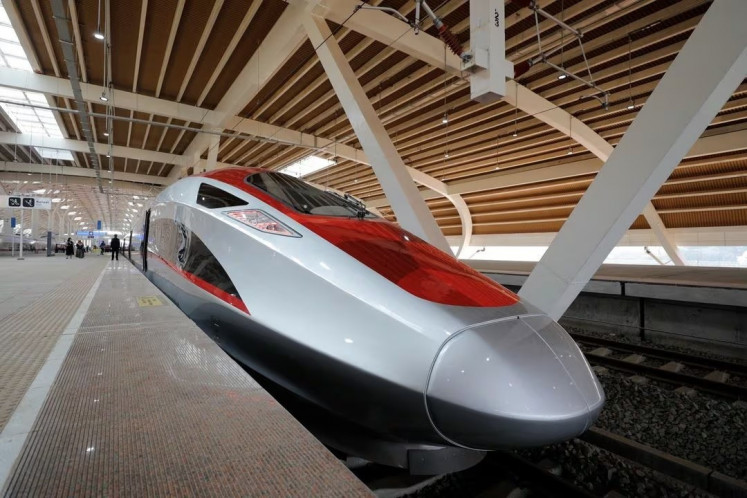Popular Reads
Top Results
Can't find what you're looking for?
View all search resultsPopular Reads
Top Results
Can't find what you're looking for?
View all search resultsDigital TV: A giant leap?
A TVRI studio films an afternoon news program
Change text size
Gift Premium Articles
to Anyone
A TVRI studio films an afternoon news program. JP/R.Berto Wedhatama
Picture yourself arriving home after work.
After sinking into your couch, you switch on your television only to find static. Shaking the set’s rabbit ears vigorously, you call it a night and go to bed.
The technology for high-definition pictures and better sound has arrived with digital television. It will free up the airwaves, creating opportunities for even more stations as well as huge amount of bandwidth for telecommunication operators. A single analog television frequency can serve up to 12 digital channels.
With the rise of personal entertainment, digital television will allow a blossoming of diverse, content-specific stations, a trend that is only found on pay TV.
More free channels might also mean an end to the current dilemma of choosing between news programs or sinetron, soap operas, at night.
Sounds great, doesn’t it? The fact is Indonesia’s migration to digital will not be easy. Just like the kerosene-to-gas conversion program that started in 2007, the migration to digital will see some challenges and resistance, despite its urgency.
“The digital switchover is not an option. It’s inevitable. If we fail to go with the flow, we will have to pay dearly for the rising costs of old analog tools, as their production will gradually decline,” Erina Tobing, the engineering director of state broadcaster TVRI told The Jakarta Post.
The country’s television technology is slated to switch from analog to the Digital Video Broadcasting — Second Generation Terrestrial (DVB-T2) format that is used in European countries, South Africa and Vietnam. Televisions and transmitters will have to follow suit.
Erina said that TVRI currently operates 376 analog transmitters, 30 of which are compatible and ready to be switched to digital. TVRI has been broadcasting digitally using four DVB transmitters in Jakarta; Bandung, West Java; Surabaya, East Java; and Batam, Riau Islands.
“Our challenge is adequate human resources, because we will run both analog and digital systems during the transition period. Another challenge is creative content because we will have to keep up with the trend of segmented TV programs,” she said.
Erina said that TVRI would continue to broadcast general interest content on TVRI National while developing “segmented” stations with more diverse content and renting unused bandwidth to local television stations and communities. The company has four television channels: TVRI’s national station and stations covering sports, education and culture.
The International Telecommunication Union (ITU) established in 2006 a path for nations to follow in their transition to digital television.
The ITU mandated that by June 17, 2015, nations must migrate from analog to digital broadcasting. Currently, 80 percent of all nations have gone digital, with 30 countries completely ending their analog broadcasts. Indonesia has only begun its migration this year and plans to end analog broadcasts in 2018, three years after the ITC’s deadline.
“From 2012 until 2017, there will be a migration period, called the simulcast period, where analog and digital programming will be transmitted together,” Anang Latif, head of the infrastructure development sub-directorate at the Communications and Information Ministry.
The experience of other nations showed that the biggest challenge in the digital switchover would be distribution of decoders that can convert digital signals for analog televisions, Anang said.
Indonesia currently has 50 million households with televisions. Unless you have a digital television, you will need a set-top box to enjoy digital broadcasts with your existing set after the switchover. The devices cost approximately Rp 135,000 (US$14.2).
Anang said the ministry was preparing a regulation so the government could provide set-top boxes to low-income people starting next year.
Television companies that plan to broadcast after the digital switch will be required to provide 6.6 million decoders to support the transition under the proposed rules.
Meanwhile, there has been no serious campaign to widely promote the conversion.
“I never heard of the migration - maybe because I barely read newspapers or watch TV. Why should we migrate?” said Grahana Sari, who lives in Yogyakarta.
Erina said that Indonesia could learn from other nations to promote its digital conversion.
Japan, for instance, alerted its citizens through various media, including making announcements in movie theaters and using celebrities to promote the migration.
Japan became the first country in Asia to end analog broadcasts in July 2011, after announcing its intentions in 1998.
“A public campaign is really the key. Another key is affordable set-top boxes. The government should choose between requiring fancy but expensive set-top boxes or prioritizing the wide use of the device by requiring the affordable ones,” Erina said.
In the US, the government provided vouchers to subsidize the purchase of converters.
SCTV corporate secretary Hardijanto Soeroso said the station was currently preparing to launch digital transmitters in Jakarta, Cilegon, Serang and Malingping.
“We hope to cover 70 percent of our service area. I hope people can prepare themselves to receive digital broadcasts along with the development of the digital transmitters,” Hardijanto said.
Hardijanto said the company planned to start digital broadcasts in September or October, but may phase in the new technology so as to not waste electricity in vain.
“Don’t only ask the TV industry about our preparedness to welcome digital TV. Ask the audience whether they are ready to face the end of analog,” Hardijanto said.
One fan of cartoons, Christophorus Fanri, 12, said he would ask his parents to equip their television with a decoder before the deadline in 2018.
“I think middle-class families can afford the decoders, but how about the poorer ones?” he said.
Your Opinion Matters
Share your experiences, suggestions, and any issues you've encountered on The Jakarta Post. We're here to listen.
Thank you
Thank you for sharing your thoughts. We appreciate your feedback.


